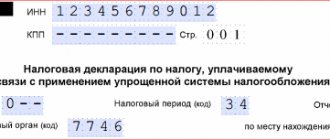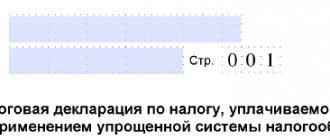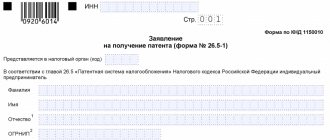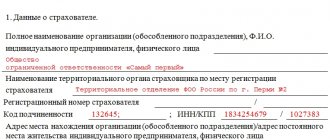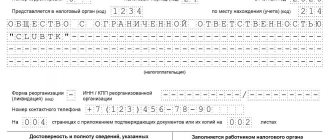Sample assignment for a business trip
Two points are worth noting:
- Business trips are divided into two types: planned and unscheduled. The sample travel assignment in question is prepared by the immediate supervisor of the employee who is sent on a business trip based on the plan.
- At the moment, the Regulations approved by Government Decree No. 749 dated October 13, 2008 (as amended on December 29, 2014) do not contain requirements for the mandatory execution of this document. However, a reason is required to issue an order. This basis becomes an official memorandum or a unified form T-10a, an official assignment, a sample of which is presented below.
Correct filling of “T-10”
Travel certificate form, approved by Resolution No. 1 in 2004. State Statistics Committee of the Russian Federation “On approval of unified forms of primary accounting documentation.”
Since 2015, organizations are not required to use the T-10 form; this obligation was abolished by Decree of the Government of the Russian Federation No. 1595 of December 29, 2014), but almost all companies (organizations) use this form to document travel expenses.
A business trip for an employee is arranged by the HR department (or HR officer). To send a company employee on a business trip, first of all, an order is issued to send the employee on a business trip and, based on the order, a travel certificate is filled out. The competence of the personnel employee is to fill out the front side of the travel certificate form, namely the full name of the employee who is sent on a business trip, the position of the employee, the place where the employee is sent and the details of the order for sending on a business trip are indicated.
After filling out the front side of the travel certificate, this certificate is handed over to the employee who is sent on a business trip and on the back side a mark is placed on the time and date of the employee’s departure from the main workplace. This mark is certified by the seal of the organization.
The reverse side of the T-10 form is filled out while the employee is on a business trip. At the place of arrival of the employee, the HR employee indicates the date of arrival with confirmation of the seal (stamp) of the organization where the employee arrived. At the end of the business trip, a mark indicating the date of departure of the seconded employee is also placed on the reverse side and is accordingly certified by the organization’s stamp.
Sample assignment for a business trip
Let's look at filling out this document step by step.
First stage. Create a job assignment
Filling out the header. We enter into the document the full name of the organization and the eight-digit OKPO code.
After this, we assign a serial number to the document. The current date is entered.
A short digression and clarification is required here. The fact is that different organizations have different numbering methods. But we recommend adhering to the rule: the details of the official assignment and the travel order must be the same. Firstly, this will avoid confusion and unnecessary work. And secondly, they are inextricably linked, one cannot exist without the other, and in this regard, such numbering is justified.
We write down the last name, first name and patronymic of the employee being sent on a business trip and his personnel number.
Now let's move on to filling out the main columns.
The first column contains the name of the structural unit of the posted worker.
The second contains the position of this employee.
The third contains the name of the country and city of destination.
The fourth is the short name of the organization to which we send our employee.
In the fifth, we enter information about the date when the employee leaves on a business trip.
The sixth entry contains the end date of the business trip.
In the seventh we put the total number of days of the trip.
In the eighth column we indicate the number of days of travel without taking into account travel time (if an employee goes from St. Petersburg to sunny Syktyvkar by train, the time he will spend on the road, going back and forth, will be five days, if by plane, then 2 hours there and back).
In the ninth we write down information about the organization that pays for the business trip.
In the tenth - information about the documents that served as the basis for the business trip (plan or memorandum).
In the eleventh column we briefly but succinctly write down the purpose of the business trip.
After filling out the indicated columns, the manager signs the document, introduces it to the employee and sends it to the personnel department to prepare a draft travel order. Personnel officers prepare an order and sign both documents from the head of the organization.
This is what a sample of filling out a work assignment for a business trip looks like, upon return from which the second stage of filling begins.
Second stage algorithm
After the employee returns from a business trip, the manager finds out whether the goals of the business trip were achieved.
The question of who fills out the 12th column is decided in agreement with the boss. The employee can write himself whether the assigned task was completed, how and to what extent. All marks are entered on the travel assignment form.
The boss, in the appropriate column of the document, makes a conclusion about the results of the trip, signs and submits the report to personnel, after which he plans new long-term goals and objectives or formulates explanations for the reasons for the unsuccessful trip to his superiors.
Form of official assignment for a business trip in 2021 (sample)
Here you can find the official assignment form t-10a.
Sample of filling out a travel certificate
Front side
The document begins with the full name of the company (an abbreviated form can also be used) and the registration code in OKPO statistics.
Next, the next number in order is entered into it, and the date of its compilation is also indicated. The certificate must also be noted in a special registration journal.
Below you enter information about the employee’s time code and his personal data - full name, position held in the organization, as well as the name of the department where this person works.
In the following columns you must indicate information about the receiving party. Basically, the name of the country, city and company to which the employee is sent is written down here.
Based on a business trip order or official assignment, the purpose of the trip, the period of its implementation, as well as the exact time of the start and end of the trip are entered.
The certificate must include a passport or other document confirming the employee’s identity, as well as its details - series and number.
The travel certificate must be endorsed by the management of the enterprise. The company's seal is also affixed here if it exists in accordance with the company's charter.
Reverse side
Below or on the other side of the document, responsible people at the enterprise and organization receiving the traveler make notes about the entry and departure of the employee.
In this case, the city, date of arrival (departure), as well as the position and personal data of the specialist whose responsibility is to keep records of this time are recorded. This information must be certified with company seals, if they are provided for by internal regulations.
The resulting image of the stamp must be clear so that all the necessary information can be read.
If the traveler has several destinations in accordance with his assignment, then when filling out the certificate it is necessary to follow the sequence of entries according to visits, so that an unambiguous chain of notes on arrival and departure is obtained.
Attention! Corrections are permitted in this document, but they must be made carefully. An incorrect entry is crossed out with a thin line so that the previous information can be read. The correct information is written at the top. After which everything is certified by the responsible person, as well as the seal of the company.
Tank T-10A "object 730A"
In 1950, the Leningrad SKB-2 (since 1951 - Special Design Bureau for Tank Building, OKBT) began developing systems for stabilizing the weapons of the T-10 tank.
This would significantly increase the probability of hitting the target when firing on the move. Tank T-10A “object 730A”
The fact is that in order to fire an aimed shot, the tank needed to stop briefly for at least a couple of minutes - this was called “firing from short stops.” In such cases, the gunner, having discovered the target, gave the command to the driver: “Short,” and the driver had to immediately stop the car. The gunner clarified the aim of the gun, fired a shot, after which the movement continued. At the same time, the tempo of the attack decreased and the time spent under targeted fire from enemy anti-tank artillery increased.
Tank T-10A during military exercises
Only on relatively flat terrain could the gunner fire an aimed shot on the move and without stopping the tank. However, statistics showed that in this case, the probability of hitting the target was only 1 - 2%, that is, there were 1 - 2 hits per 100 shots. Considering that the ammunition load of most tanks did not exceed 50 shells, it could be assumed that when firing on the move, the tank, even having fired all its ammunition, might not hit the target at all.
Commander's cupola of the T-10A tank. Observation devices are clearly visible
Two options for stabilizing tank weapons were considered.
In the first, force stabilization of the gun and turret, in which the gun and the sight rigidly connected to it constantly monitor the target. In the second, high-precision stabilization of the field of view of the sight and power stabilization of the gun and turret were provided. The disadvantage of the first option was that during loading, when the gun was blocked at given elevation angles, the gunner was deprived of the opportunity to observe the target. The second option was devoid of such a drawback, which greatly facilitated the gunner’s working conditions, but turned out to be much more difficult to manufacture and operate. OKBT designers under the leadership of G. Andandonsky took a more difficult path. They developed a technical project together with the Krasnogorsk Mechanical Plant, proposing at the first stage to stabilize the weapons only in the vertical plane, vibrations in which were of greatest importance for hitting the target. Turret of the T-10A tank: 1 — tide for the TPS-1 sight, 2 — bracket for the TPS-1 sight, 3 — fan cap, 4 — loader hatch cover, 5 — antenna input cup, 6 — commander’s hatch cover, 7 — handrail.
8 — hole for the observation device, 9 — eye, 10 — hole for the cannon frame mounting rod, 11 — rain shield, 12 — window for the sight, 13 — window for the DShK machine gun. Such a stabilization system was tested on a prototype of the vehicle, registered as “object 267 sp.1” (sp. 1 - first specification). The developers used a fundamentally new periscopic optical-gyroscopic sight TPS-1 (tank periscopic stabilized), one of its mirrors was stabilized in the vertical plane using a gyroscopic device. Precise guidance was ensured by an electro-hydraulic drive due to the operation of the sensor based on the difference in the installation angles of the sight and gun. Tests have shown that such a system “with an independent line of sight” turned out to be much more effective than the “dependent” one adopted later on the T-54/55 medium tank, in which the gun was stabilized by gyroscope sensors, and the sight had a rigid mechanical connection with it. Thus, the modernized D-25TS gun received a single-plane stabilizer PUOT-1 “Hurricane”. The installation of new drives entailed a change in the shape of the armored mantlet and the front part of the turret. A characteristic external difference of the D-25TS gun was the presence of an ejector on its barrel, which made it possible to significantly reduce gas contamination in the fighting compartment during firing.
General view of the T-10A tank
In mid-1955, the Kirov plant produced five samples of the Object 267 sp.1 tank and carried out a full cycle of tests of the stabilization system. The T-10 tank with a single-plane gun stabilizer was adopted by the Soviet Army under the designation T-10A by Government Decree No. 649-378ss dated May 17 and by order of the Minister of Defense dated June 11, 1956. In the same year, the Chelyabinsk Tractor Plant began mass production of such vehicles designated “object 730A”. In 1956, they managed to build 30 T-10A tanks. Simultaneously with the stabilization of the gun, the TVN-1 night vision device for the driver and the GPK-48 gyro-compass were also introduced on the T-10A.
Source: Armor Collection 4'09
Document structure
The travel certificate contains the following information:
- name of the enterprise in accordance with the constituent documents;
- date of completion of the document and its number;
- data of an employee sent to another enterprise, namely, full name, personnel number, position held by him, as well as service or division;
- location of the enterprise to be visited;
- the purpose of the trip, which is transferred from the official assignment;
- duration of the business trip in days;
- details of the identity document of the employee sent on a business trip;
- signature of the director of the enterprise.
and a sample of filling out form No. T10
On the reverse side of form No. T10 there is data relating to all information about arrival and departure from places of business with the corresponding dates. The name of the enterprise to which the employee was sent and his address are also indicated here.
In each of these places, all data must be certified by the chief accountant or an authorized person, including the head of the personnel department, and the organization’s seal must be affixed. If these requirements are not met, then upon arrival back to your permanent place of work, many questions may arise, and your business trip may simply not be accepted.

